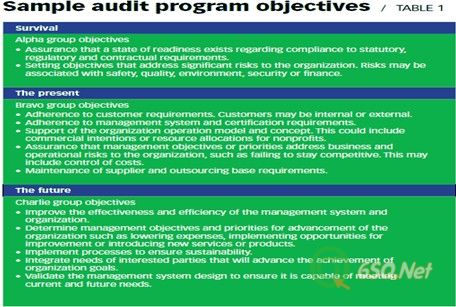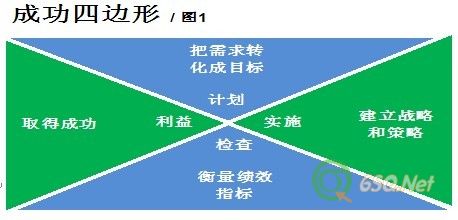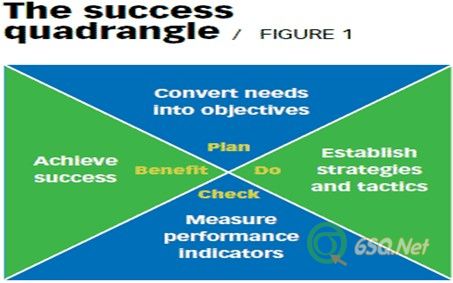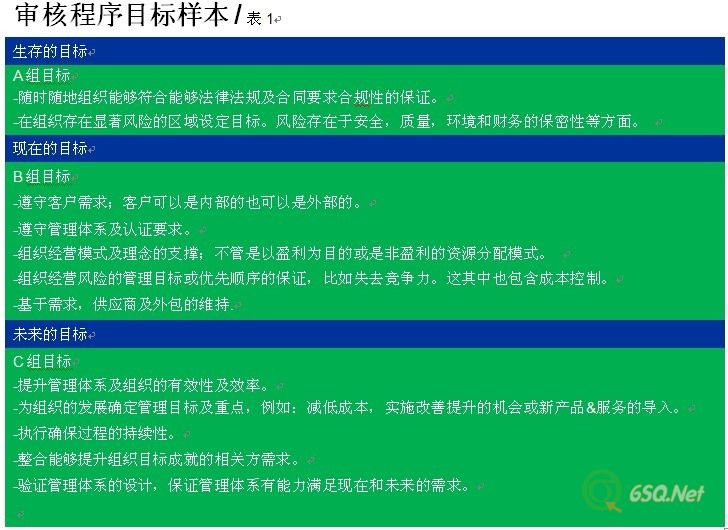第二十七篇 Gauge Audit Program Value
本帖最后由 小编D 于 2012-2-20 15:36 编辑
本文由chengguo0740翻译 Sol_Sun校稿
Gauge Audit Program Value
Internal programs must provide real benefits
衡量审核程序的价值
内部程序必须提供实实在在的好处
by J.P. Russell J.P. 拉塞尔编写
Today’s organizations need to be agile and responsive to the changing requirements in private and public business sectors. Properly directed, internal audit program resources can help an organization stay focused and uncover new improvement opportunities.
现今的组织需要去变得灵活且能快速响应私有及公共事务发展变化的需求。如果内部审核程序资源正确使用的话,它能帮助组织,保持长盛不衰并且发现新的改善机会。
Unfortunately, the effectiveness of many audit programs is limited to counting findings or other simplistic measures. Effective audit programs, however, should provide insight and support the organization’s objectives. But some organizations are not even sure how to gauge the effectiveness of their audit program.
不幸的是,在计算审核发现及其他简单措施方面,很多审核程序的有效性是有限的。不管怎么样,有效的审核应当提供深刻的见解并支持组织的目标。但是,有些组织甚至不知道如何衡量他们的审核程序的有效性。
At first glance, gauging the effectiveness of your internal audit program may seem easy. If you have accomplished your objectives, the audit program is effective. But as you start to list the organization’s, department’s and audit program’s objectives, things start to get fuzzy. What methods will you use, and what measures do you need to monitor?
乍看之下,衡量你们内部审核程序的有效性似乎很容易。假如你完成了你的目标、审核程序是有效的。但是当你开始罗列组织的、部门的以及审核程序的目标时,事情开始变得复杂了。什么样的方式方法你将采用?以及什么样的措施你需要去监控?
Note that while this column is about internal audit programs, the same techniques can be applied to any department or function simply by changing names and examples.
值得留意的是,虽然这个专栏是关于内部审核程序;但是同样的方法可以简单地应用于任何一个只能部门,仅仅只需改变名字和例子。
After a few minutes of scratching your head, you may be tempted to go back to counting audits conducted, nonconformities issued and closed corrective actions as your key performance indicators (KPI)—but please resist.
挠头几分钟后,你或许会想:那我回到内部审核的实施,用及不符合的提出到纠正措施的关闭来作为关键绩效指标(KPI)行了吧?但是,请稍安勿躁。
Effectiveness of the audit program should be of interest to audit managers and auditor team members: managers, because they should be making the right decisions to continually improve the internal audit function and auditors because they will be asked for their input and agreement on the performance parameters by which they will be judged.
审核过程的有效性应当是审核管理者和审核组成员的兴趣所在:管理者,因为他们应当作出正确的决定去持续改善内部审核工作;审核员,因为他们被要求关于他们对绩效参数的输入及看法。
Effectiveness 有效性
Gauging the effectiveness of an internal audit program can be complicated. We want what we do to be effective, but sometimes we are not sure what effective means or how to determine it.
衡量内部审核程序的有效性可能会很复杂。我们希望我们所做的是有效的;但是有些时候,我们不能确定有效性意味着什么或者怎样去确定它。
The dictionary definitions for effectiveness are too numerous and too vague for application in a technical field. In 1995, in After the Quality Audit, I explained that the effectiveness of a system or process is based on two components: process and product.
对于在技术领域是应用来说,在字典中,有着太多而且太模糊关于有效性的定义。1955年,在《在质量审核之后》一书中,我解释道,一个系统或者过程的有效性是建立在两个部分的基础上:过程和产品。
The system or process is effective in two circumstances:
For example, adding three inspection steps to achieve the desired quality output may achieve the output objective (the product) but would make the process less efficient and perhaps less capable. There must be a proper balance between the two components (product and process This means the end does not justify the means.
例如,为了达到质量的输出而增加三个检验步骤,或许真的可以达到产品的质量输出,但同样也会导致生产过程效率的下降,甚至可能产能的下降。 所以在这产品和过程这两者之间,必须取得适当的平衡;产品和过程,这并不意味着结果能证明过程。
In 2000, ISO 9000 added a definition for the word “effectiveness to its vocabulary: the extent to which planned activities are realized and planned results achieved. In an elegant manner, it combined the two components’ processes (planned arrangements) and product (results achieved Knowing what effective means is important because effective processes lead to an effective and successful organization.
在2000年,ISO9000在它的词汇表里为“有效性”增加一个释义:完成策划的活动并得到策划结果的程度。用一句简洁的方式来说,它包含两部分:过程(计划安排)和产品(过程的结果)。知道有效性的意思是重要的,因为有效地过程能导致一个有效的和成功的组织。
As you can see, the number of audits conducted or corrective action requests closed are not adequate KPIs of the effectiveness of the internal audit program. Counting audits addresses only the process and not the outcome (product
正如你所看能到的,审核实施或者纠正措施关闭项的数量不是一个内部审核程序有效性的适当的关键绩效指标。计算审核次数只能说明“过程”而不是“结果”。
Audit program objectives 审核程序目标
Audit program performance indicators should be based on objectives that reflect the audit program mission and organizational objectives and goals. The organizational or function objectives and goals are the big picture of where you want to be one to five years from now.
审核程序绩效指标应该建立在反映审核程序愿景以及组织目标&指标之上。组织或部门目标&指标是指一个蓝图:未来一到五年内,你想做到什么的。
Not all objectives are equally important to the organization or audit program. The objectives that avoid the greatest risks and identify the greatest opportunities for improvement are the most important.
对于组织和审核程序而言并不是所有的目标都同等重要。那些能最大规避风险且能识别改善机会的目标才是最重要的。
For this column, I am going to lump objectives and goals into three groupings:
在这篇专栏文章里,我会把目标&指标揉合到三个组合里面来说明:
The Alpha-Bravo-Charlie order is not necessarily the order of importance of the individual organization’s objective or goal. Your organization probably already has groupings of some kind. Table 1 shows some examples of audit program objectives adapted from ISO 19011,2 clause 5.2.1.
由A-B-C的顺序并不一定是个别组织目标和指标的重要性顺序。你的组织很可能已经有了某种形式的组合。表1是一些适合于ISO 19011,2中,第5.2.1条款的审核程序目标的示例。
You have auditing objectives, but because internal audits are a service for internal customers, you should also consider internal customer objectives when performing the service. For example, if you are a licensed barber or beautician, should you cut someone’s hair how you think best, or should you consider your customer’s objectives as you perform your professional duties?
即使你有了审核的目标,但是由于内部审核是服务于内部客户的,在审核时你也应当考虑到内部客户的目标。举个例子来说吧,假设你是个有资质的理发师或美容师,你是把他的头发剪成你认为最好的,还是考虑下客户的想法?那你在执行你专业的审核时该怎么做呢?答案是很显而易见的。
If you are conducting second-party supplier audits and have good relationships with your suppliers, you may want to be aware of their objectives relevant to the product or service they provide.
如果有你和一家供应商有着良好的合作关系,并且你正在执行第二方供应商审核,那么你何不试着去了解下他们提供给你的服务或产品有关的目标呢?
For third-party certification audits, you may need to verify that the auditee organization has objectives that are promulgated throughout the organization, but you do not need to consider them as part of the audit purpose. It may be good business to do so, however.
对于三方认证审核来说,你需要确认被审核组织有目标,并被传达到各相关单位,但是这不应当成为你审核目的的一部分。但不管怎样,如果那样做了,或许是家不错的公司。
Independent third-party auditors from governmental agencies need not be concerned with auditee organization objectives as long as the organization complies with statutory and regulatory requirements. However, some regulatory agencies believe that auditee objectives improve ongoing compliance, as well as effectiveness.
只要组织符合法律法规要求,来自于政府机构的独立的第三方审核员没有必要关注被审组织的目标。然而,一些监管机构认为受审核组织目标能持续改善法律法规及标准的符合性,也就是说有效性。
Strategies 战略
Once you know the objectives, you, as the manager, or your management team can develop strategies to achieve the audit program objectives. The strategies will be based on the type of organization, the organizational culture and resources. Some of the strategies may be simply to formalize what you are already doing.
一旦你知道了目标,作为管理者的你或你的管理团队就能开发出达成到审核程序目标的策略。当然,这些策略是基于组织的类型、文化和资源之上;或许一些策略只要很简单地将你们已经正在做的事情程序化就可以。
If there was an objective to continually improve, some audit program strategies and tactics may include:
出于持续改善的目的,一些审核程序战略和策略可能包括:
• Developing a process to collect complaints or feedback from audit program customers (auditee, audit program manager, stockholders, top management, function managers and supervisors). By collecting feedback, audit program management can learn what works and what doesn’t work, as well as identify customer needs.
开发一个程序去收集从审核程序顾客(被审单位、审核程序管理者、股东、高层管理者、部门经理及主管)的抱怨或者反馈。通过收集反馈,审核程序管理能得知做什么和不做什么,以及识别顾客需求。
• Adding value by reviewing department or area objectives as part of audit preparation and including them in the audit statement of purpose for that department or area when appropriate.
增加通过确认部门或工作范围的目标作为审核准备的价值;并且在适当的时候,在部门或工作范围目的的审核有关的陈述中概括他们。
• Identifying and reporting completed corrective actions that improved or changed the system or process.
识别并且报告已经完成了的哪些改善或改变了系统或过程的纠正措施。
• Upgrading auditor competency for observing and reporting performance issues.
提升审核员能力来观察和报告工作问题。
• Verifying claimed improvements by organization functions and reporting findings to top management.
验证改进组织&部门要求的改善,并且报告审核发现给最高管理层。
• Implementing real-time audit reporting using mobile technology.
实施实时审核,并使用灵活的方式&语言来报告。
Another objective may be to maintain continuous compliance using fewer resources, with audit program strategies or tactics that could include:
另一个目的是,用较少的资源与审核程序战略和策略来保持持续的合规性,其可能包括:
• Reducing resources used to audit areas demonstrating continuous compliance by decreasing audit frequency or conducting mini audits supported by independently supported data (compliance indicators based on performance
通过降低审计频率,或实施有独立数据(基于绩效的合规指标)支持的小型审核来减少用于展示持续合规性的审核范围的资源。
• Establishing a network of audit advisors for areas needing assistance to comply based on past results.
基于过去的结果,为那些需要合规性帮助的区域建立一个审核顾问网络。
• Implementing a program to schedule audits based on changes in processes or key personnel to identify and prevent noncompliances by external auditors.
基于过程或关键人员的变化,执行一个程序去安排审核的时间表,通过外部审核员来识别并且预防不符合的发生。
• Identifying situations in which outsourcing is a more cost-effective alternative than in-house oversight.
识别那种方案是更划算的,外包给别人?还是自己来做?
• Establishing and implementing an e-audit program.
创建一个电子版的审核计划,并执行之。
We have discussed the first two steps (plan and do) of the success quadrangle (see Figure 1) . Next, we need to establish performance measures that will result in the successful achievement of the objectives.
我们已经讨论了“成功四步骤”的前两个步骤(计划和做)(见图1)。 下一步,我们需要建立一个能够导致成功达成目标的绩效评估系统,
KPIs 关键绩效指标
Now that you have determined how to achieve objectives and goals, it is time to develop KPIs to ensure you stay on track. KPIs should be quantifiable measurements that are agreed to beforehand.
现在,你已经有了决定,怎么去达成这个目标指标呢?是时候去找出是是你不偏离目标指标的关键绩效指标了。
关键绩效指标应当是事先同意的,并且是可以计量的。
A KPI may be to achieve milestones during the implementation of a feedback program. Another one may be to maintain a 95% internal customer satisfaction rating for the audit program. A KPI for ongoing compliance could be to have no serious findings from external auditing organizations—just minor findings requiring remedial action with no system problems.
一个关键绩效指标可能是在一个反馈程序执行期间达成的时间表;另一个关键绩效指标可能是在审核程序保持95%的内部顾客满意率。一个持续符合的关键绩效指标不能有系统问题存在的严重的不符合发生,仅仅只能有需要采取纠正行动的一般不符合。
Process performance indicators may be the monitoring of internal complaints related to delivery of the service, redoing things or meeting agreed-on commitments.
过程绩效指标可能是内部抱怨的监测,这些监测可能与服务的交付、返工或者满足达成的承诺有关。
Some desirable performance indicators, including the following examples, are less quantifiable:
一些有用的性能指标是不可以或很难量化的,包括以下的例子:
• Do corrective action plans address the fundamental cause (not the symptom)?
纠正措施计划能解决根本的原因(不是现象)吗?
• Do they contain real root causes?
它们包含真正的根本性原因吗?
• Were plans on time?
计划准时吗?
• Are solutions realistic (viable considering the environment)?
解决方法可行吗(考虑到环境切实可行)?
• Is the timetable for change reasonable?
计划时间表的变化合理吗
For these less-quantifiable indicators, you might grade corrective action plans based on a marking scheme similar to those for essay tests, with a 100% grade matching all expectations.
针对这些不可以或很难量化的指标,你或许可以像作文考试一样建立一个评分标准去将纠正行动分级评分,符合所有的期望值就满分。。。。。。
This same technique could be used to improve the effectiveness of audit reports. For example:
相同的技巧可以被用于提高审核报告的有效性。例如:
• Do audit reports link findings to objectives or customer requirements?
审核报告有将审核发现与目标或者顾客需求联系到一起了吗?
• When possible, are findings quantified and analyzed?
如果可能的话,审核发现有做量化和分析吗?
• Is report terminology appropriate for the users of the report?
报告的术语适用于报告的使用者吗?
• Are attachments, examples, diagrams or images used to improve report effectiveness?
有用附件、例子、图表或者图片来提高报告有效性吗?
• Are unfamiliar terms defined?
不常见的术语有定义,解释吗?
Once you have established your performance indicators, be prepared to change them when objectives change.
即使你已经建立了你的绩效指标;但当目标发生变化时,请更改你的绩效指标。
Everyone involved in the audit program (auditors, staff, supervisors) should be focused on meeting or exceeding KPIs. You can post the KPIs in conference rooms, the lunch room and on the company intranet or website to keep everyone informed of your progress.
每一个参与到审核程序的人(审核员、员工、管理者)都应关注达到或者超越关键绩效指标。你可以把关键绩效指标张贴在会议室、餐厅、公司内部互联网或者网站上,以使每个人了解你的进度。
Additional ideas for audit program strategies and performance indicators can be found in the latest edition of After the Quality Audit.3
更多关于审核程序战略和绩效指标的想法能在最新版的《质量审核之后》中找到。
Effective and efficient 有效的和高效的
An effective internal audit program is one that achieves its objectives via processes that are capable and efficient. It is about doing it right the first time and being lean. You will need output measures and process measures to verify the audit program is effective and efficient.
一个有效的内部审核程序,能够凭借其精干高效的过程来达到它的目标。这就是“第一次就把事情做对”,也称作精益。你需要结果和过程的测量,以验证该审核程序是有效及高效的。
The audit function provides a valuable service for the organization. As with any service, it should be done right and professionally. Operate as if you were competing with other audit organizations and could lose the business. What value-added services does your audit program offer? What innovations are planned for future services? Can you demonstrate that you address your customer needs?
审计部门为组织提供一项有价值的服务。和任何服务一样,他应当是专业和正确的实施。就像你正在同其他审核组织竞争而且可能失去这份生意一样去操作。你的审核程序提供了什么附加价的服务呢?为未来的服务策划了什么创新呢?你能证明你解决了顾客的需要吗?
Many managers and executives have low expectations of audit programs. Many view audit programs as the cost of doing business to ensure compliance to regulations. Once audit program managers can demonstrate the effectiveness of how the audit program supports the organization’s objectives, managers will start to see that audit program verification services can add value beyond compliance to the law.
很多经理和主管对审核程序抱有很低的期望。很多人把审核程序看作是一种为了确保合法合规而去做事情的成本。一旦审核程序管理者能够证明审核程序是如何支持组织目标的有效性,那么管理者将开始开到审核程序并不仅仅是一种合法合规性验证服务。
Auditors represent an independent set of eyes supporting the insight that is needed in our fast-paced world economy. We need to ensure we are putting solved problems behind us and are continually advancing our organizations to optimize their chances of success.
审核员代表一种独立的视角,给我们提供了在快节奏的世界经济体制中所需的洞察力。我们需要去做的是,确保我们正把已解决的事情抛在身后,并且使得我们的组织不断的前进,以增加组织取得成功的机会。
References 参考文献
1. J.P. Russell, After the Quality Audit, ASQ Quality Press, 1995.
J.P. Russell is president of J.P. Russell & Associates in Gulf Breeze, FL, and managing director for Quality WBT Center for Education. He is a fellow of ASQ, an ASQ-certified quality auditor, voting member of the American National Standards Institute/ASQ Z1 committee, a member of the U.S. technical advisory group for International Organization for Standardization technical committee 176 and member of the Standards Engineering Society. Russell is the author of several ASQ Quality Press books, including Internal Auditing Basics (second edition), ISO Lesson Guide 2008 (third edition) and Process Auditing Techniques, and editor of the ASQ Auditing Handbook (third edition
J.P.拉塞尔是J.P.拉塞尔和佛罗里达州微风港城联合会的主席,WBT质量教育中心执行董事,ASQ会员,ASQ注册质量审核员,美国国家标准委员会/ASQ Z1委员会选举委员,TC176美国技术顾问组成员,机械标准协会成员。拉塞尔是几个ASQ质量出版社书籍的作者,包括《内部审核基础》(第二版)、《ISO经验指导2008》(第三版)和《过程审核技术》,还是《ASQ审核手册》(第三版)的编辑
本文由chengguo0740翻译 Sol_Sun校稿
Gauge Audit Program Value
Internal programs must provide real benefits
衡量审核程序的价值
内部程序必须提供实实在在的好处
by J.P. Russell J.P. 拉塞尔编写
Today’s organizations need to be agile and responsive to the changing requirements in private and public business sectors. Properly directed, internal audit program resources can help an organization stay focused and uncover new improvement opportunities.
现今的组织需要去变得灵活且能快速响应私有及公共事务发展变化的需求。如果内部审核程序资源正确使用的话,它能帮助组织,保持长盛不衰并且发现新的改善机会。
Unfortunately, the effectiveness of many audit programs is limited to counting findings or other simplistic measures. Effective audit programs, however, should provide insight and support the organization’s objectives. But some organizations are not even sure how to gauge the effectiveness of their audit program.
不幸的是,在计算审核发现及其他简单措施方面,很多审核程序的有效性是有限的。不管怎么样,有效的审核应当提供深刻的见解并支持组织的目标。但是,有些组织甚至不知道如何衡量他们的审核程序的有效性。
At first glance, gauging the effectiveness of your internal audit program may seem easy. If you have accomplished your objectives, the audit program is effective. But as you start to list the organization’s, department’s and audit program’s objectives, things start to get fuzzy. What methods will you use, and what measures do you need to monitor?
乍看之下,衡量你们内部审核程序的有效性似乎很容易。假如你完成了你的目标、审核程序是有效的。但是当你开始罗列组织的、部门的以及审核程序的目标时,事情开始变得复杂了。什么样的方式方法你将采用?以及什么样的措施你需要去监控?
Note that while this column is about internal audit programs, the same techniques can be applied to any department or function simply by changing names and examples.
值得留意的是,虽然这个专栏是关于内部审核程序;但是同样的方法可以简单地应用于任何一个只能部门,仅仅只需改变名字和例子。
After a few minutes of scratching your head, you may be tempted to go back to counting audits conducted, nonconformities issued and closed corrective actions as your key performance indicators (KPI)—but please resist.
挠头几分钟后,你或许会想:那我回到内部审核的实施,用及不符合的提出到纠正措施的关闭来作为关键绩效指标(KPI)行了吧?但是,请稍安勿躁。
Effectiveness of the audit program should be of interest to audit managers and auditor team members: managers, because they should be making the right decisions to continually improve the internal audit function and auditors because they will be asked for their input and agreement on the performance parameters by which they will be judged.
审核过程的有效性应当是审核管理者和审核组成员的兴趣所在:管理者,因为他们应当作出正确的决定去持续改善内部审核工作;审核员,因为他们被要求关于他们对绩效参数的输入及看法。
Effectiveness 有效性
Gauging the effectiveness of an internal audit program can be complicated. We want what we do to be effective, but sometimes we are not sure what effective means or how to determine it.
衡量内部审核程序的有效性可能会很复杂。我们希望我们所做的是有效的;但是有些时候,我们不能确定有效性意味着什么或者怎样去确定它。
The dictionary definitions for effectiveness are too numerous and too vague for application in a technical field. In 1995, in After the Quality Audit, I explained that the effectiveness of a system or process is based on two components: process and product.
对于在技术领域是应用来说,在字典中,有着太多而且太模糊关于有效性的定义。1955年,在《在质量审核之后》一书中,我解释道,一个系统或者过程的有效性是建立在两个部分的基础上:过程和产品。
The system or process is effective in two circumstances:
- When it achieves the desired result that is consistent with organizational objectives (the product
- When the process is capable, efficient and consistent with objectives (the process
- 当组织达成了它想要的结果,也就是说与组织的(产品)目标保持一致时;
- 当过程是有能力的、有效率的并且与(过程)目标保持一致时;
For example, adding three inspection steps to achieve the desired quality output may achieve the output objective (the product) but would make the process less efficient and perhaps less capable. There must be a proper balance between the two components (product and process This means the end does not justify the means.
例如,为了达到质量的输出而增加三个检验步骤,或许真的可以达到产品的质量输出,但同样也会导致生产过程效率的下降,甚至可能产能的下降。 所以在这产品和过程这两者之间,必须取得适当的平衡;产品和过程,这并不意味着结果能证明过程。
In 2000, ISO 9000 added a definition for the word “effectiveness to its vocabulary: the extent to which planned activities are realized and planned results achieved. In an elegant manner, it combined the two components’ processes (planned arrangements) and product (results achieved Knowing what effective means is important because effective processes lead to an effective and successful organization.
在2000年,ISO9000在它的词汇表里为“有效性”增加一个释义:完成策划的活动并得到策划结果的程度。用一句简洁的方式来说,它包含两部分:过程(计划安排)和产品(过程的结果)。知道有效性的意思是重要的,因为有效地过程能导致一个有效的和成功的组织。
As you can see, the number of audits conducted or corrective action requests closed are not adequate KPIs of the effectiveness of the internal audit program. Counting audits addresses only the process and not the outcome (product
正如你所看能到的,审核实施或者纠正措施关闭项的数量不是一个内部审核程序有效性的适当的关键绩效指标。计算审核次数只能说明“过程”而不是“结果”。
Audit program objectives 审核程序目标
Audit program performance indicators should be based on objectives that reflect the audit program mission and organizational objectives and goals. The organizational or function objectives and goals are the big picture of where you want to be one to five years from now.
审核程序绩效指标应该建立在反映审核程序愿景以及组织目标&指标之上。组织或部门目标&指标是指一个蓝图:未来一到五年内,你想做到什么的。
Not all objectives are equally important to the organization or audit program. The objectives that avoid the greatest risks and identify the greatest opportunities for improvement are the most important.
对于组织和审核程序而言并不是所有的目标都同等重要。那些能最大规避风险且能识别改善机会的目标才是最重要的。
For this column, I am going to lump objectives and goals into three groupings:
在这篇专栏文章里,我会把目标&指标揉合到三个组合里面来说明:
- Alpha group: critical for the organization or function to operate. Top management wants to know if the organization adheres to all applicable standards to ensure critical licenses and certifications will be retained.
- A组:出于证书的需要。对于高层管理者来说,他们想要知道组织或部门运作关键的是:假如遵循所有可适用的标准的话,那么能否确保哪些关键的许可证和证书能被维持。
- Bravo group: necessary for day-to-day management.
- B组:出于日常管理的需要。
- Charlie group: required for advancement and growth.
- C组:出于发展和成长的需要。
The Alpha-Bravo-Charlie order is not necessarily the order of importance of the individual organization’s objective or goal. Your organization probably already has groupings of some kind. Table 1 shows some examples of audit program objectives adapted from ISO 19011,2 clause 5.2.1.
由A-B-C的顺序并不一定是个别组织目标和指标的重要性顺序。你的组织很可能已经有了某种形式的组合。表1是一些适合于ISO 19011,2中,第5.2.1条款的审核程序目标的示例。
You have auditing objectives, but because internal audits are a service for internal customers, you should also consider internal customer objectives when performing the service. For example, if you are a licensed barber or beautician, should you cut someone’s hair how you think best, or should you consider your customer’s objectives as you perform your professional duties?
即使你有了审核的目标,但是由于内部审核是服务于内部客户的,在审核时你也应当考虑到内部客户的目标。举个例子来说吧,假设你是个有资质的理发师或美容师,你是把他的头发剪成你认为最好的,还是考虑下客户的想法?那你在执行你专业的审核时该怎么做呢?答案是很显而易见的。
If you are conducting second-party supplier audits and have good relationships with your suppliers, you may want to be aware of their objectives relevant to the product or service they provide.
如果有你和一家供应商有着良好的合作关系,并且你正在执行第二方供应商审核,那么你何不试着去了解下他们提供给你的服务或产品有关的目标呢?
For third-party certification audits, you may need to verify that the auditee organization has objectives that are promulgated throughout the organization, but you do not need to consider them as part of the audit purpose. It may be good business to do so, however.
对于三方认证审核来说,你需要确认被审核组织有目标,并被传达到各相关单位,但是这不应当成为你审核目的的一部分。但不管怎样,如果那样做了,或许是家不错的公司。
Independent third-party auditors from governmental agencies need not be concerned with auditee organization objectives as long as the organization complies with statutory and regulatory requirements. However, some regulatory agencies believe that auditee objectives improve ongoing compliance, as well as effectiveness.
只要组织符合法律法规要求,来自于政府机构的独立的第三方审核员没有必要关注被审组织的目标。然而,一些监管机构认为受审核组织目标能持续改善法律法规及标准的符合性,也就是说有效性。
Strategies 战略
Once you know the objectives, you, as the manager, or your management team can develop strategies to achieve the audit program objectives. The strategies will be based on the type of organization, the organizational culture and resources. Some of the strategies may be simply to formalize what you are already doing.
一旦你知道了目标,作为管理者的你或你的管理团队就能开发出达成到审核程序目标的策略。当然,这些策略是基于组织的类型、文化和资源之上;或许一些策略只要很简单地将你们已经正在做的事情程序化就可以。
If there was an objective to continually improve, some audit program strategies and tactics may include:
出于持续改善的目的,一些审核程序战略和策略可能包括:
• Developing a process to collect complaints or feedback from audit program customers (auditee, audit program manager, stockholders, top management, function managers and supervisors). By collecting feedback, audit program management can learn what works and what doesn’t work, as well as identify customer needs.
开发一个程序去收集从审核程序顾客(被审单位、审核程序管理者、股东、高层管理者、部门经理及主管)的抱怨或者反馈。通过收集反馈,审核程序管理能得知做什么和不做什么,以及识别顾客需求。
• Adding value by reviewing department or area objectives as part of audit preparation and including them in the audit statement of purpose for that department or area when appropriate.
增加通过确认部门或工作范围的目标作为审核准备的价值;并且在适当的时候,在部门或工作范围目的的审核有关的陈述中概括他们。
• Identifying and reporting completed corrective actions that improved or changed the system or process.
识别并且报告已经完成了的哪些改善或改变了系统或过程的纠正措施。
• Upgrading auditor competency for observing and reporting performance issues.
提升审核员能力来观察和报告工作问题。
• Verifying claimed improvements by organization functions and reporting findings to top management.
验证改进组织&部门要求的改善,并且报告审核发现给最高管理层。
• Implementing real-time audit reporting using mobile technology.
实施实时审核,并使用灵活的方式&语言来报告。
Another objective may be to maintain continuous compliance using fewer resources, with audit program strategies or tactics that could include:
另一个目的是,用较少的资源与审核程序战略和策略来保持持续的合规性,其可能包括:
• Reducing resources used to audit areas demonstrating continuous compliance by decreasing audit frequency or conducting mini audits supported by independently supported data (compliance indicators based on performance
通过降低审计频率,或实施有独立数据(基于绩效的合规指标)支持的小型审核来减少用于展示持续合规性的审核范围的资源。
• Establishing a network of audit advisors for areas needing assistance to comply based on past results.
基于过去的结果,为那些需要合规性帮助的区域建立一个审核顾问网络。
• Implementing a program to schedule audits based on changes in processes or key personnel to identify and prevent noncompliances by external auditors.
基于过程或关键人员的变化,执行一个程序去安排审核的时间表,通过外部审核员来识别并且预防不符合的发生。
• Identifying situations in which outsourcing is a more cost-effective alternative than in-house oversight.
识别那种方案是更划算的,外包给别人?还是自己来做?
• Establishing and implementing an e-audit program.
创建一个电子版的审核计划,并执行之。
We have discussed the first two steps (plan and do) of the success quadrangle (see Figure 1) . Next, we need to establish performance measures that will result in the successful achievement of the objectives.
我们已经讨论了“成功四步骤”的前两个步骤(计划和做)(见图1)。 下一步,我们需要建立一个能够导致成功达成目标的绩效评估系统,
KPIs 关键绩效指标
Now that you have determined how to achieve objectives and goals, it is time to develop KPIs to ensure you stay on track. KPIs should be quantifiable measurements that are agreed to beforehand.
现在,你已经有了决定,怎么去达成这个目标指标呢?是时候去找出是是你不偏离目标指标的关键绩效指标了。
关键绩效指标应当是事先同意的,并且是可以计量的。
A KPI may be to achieve milestones during the implementation of a feedback program. Another one may be to maintain a 95% internal customer satisfaction rating for the audit program. A KPI for ongoing compliance could be to have no serious findings from external auditing organizations—just minor findings requiring remedial action with no system problems.
一个关键绩效指标可能是在一个反馈程序执行期间达成的时间表;另一个关键绩效指标可能是在审核程序保持95%的内部顾客满意率。一个持续符合的关键绩效指标不能有系统问题存在的严重的不符合发生,仅仅只能有需要采取纠正行动的一般不符合。
Process performance indicators may be the monitoring of internal complaints related to delivery of the service, redoing things or meeting agreed-on commitments.
过程绩效指标可能是内部抱怨的监测,这些监测可能与服务的交付、返工或者满足达成的承诺有关。
Some desirable performance indicators, including the following examples, are less quantifiable:
一些有用的性能指标是不可以或很难量化的,包括以下的例子:
• Do corrective action plans address the fundamental cause (not the symptom)?
纠正措施计划能解决根本的原因(不是现象)吗?
• Do they contain real root causes?
它们包含真正的根本性原因吗?
• Were plans on time?
计划准时吗?
• Are solutions realistic (viable considering the environment)?
解决方法可行吗(考虑到环境切实可行)?
• Is the timetable for change reasonable?
计划时间表的变化合理吗
For these less-quantifiable indicators, you might grade corrective action plans based on a marking scheme similar to those for essay tests, with a 100% grade matching all expectations.
针对这些不可以或很难量化的指标,你或许可以像作文考试一样建立一个评分标准去将纠正行动分级评分,符合所有的期望值就满分。。。。。。
This same technique could be used to improve the effectiveness of audit reports. For example:
相同的技巧可以被用于提高审核报告的有效性。例如:
• Do audit reports link findings to objectives or customer requirements?
审核报告有将审核发现与目标或者顾客需求联系到一起了吗?
• When possible, are findings quantified and analyzed?
如果可能的话,审核发现有做量化和分析吗?
• Is report terminology appropriate for the users of the report?
报告的术语适用于报告的使用者吗?
• Are attachments, examples, diagrams or images used to improve report effectiveness?
有用附件、例子、图表或者图片来提高报告有效性吗?
• Are unfamiliar terms defined?
不常见的术语有定义,解释吗?
Once you have established your performance indicators, be prepared to change them when objectives change.
即使你已经建立了你的绩效指标;但当目标发生变化时,请更改你的绩效指标。
Everyone involved in the audit program (auditors, staff, supervisors) should be focused on meeting or exceeding KPIs. You can post the KPIs in conference rooms, the lunch room and on the company intranet or website to keep everyone informed of your progress.
每一个参与到审核程序的人(审核员、员工、管理者)都应关注达到或者超越关键绩效指标。你可以把关键绩效指标张贴在会议室、餐厅、公司内部互联网或者网站上,以使每个人了解你的进度。
Additional ideas for audit program strategies and performance indicators can be found in the latest edition of After the Quality Audit.3
更多关于审核程序战略和绩效指标的想法能在最新版的《质量审核之后》中找到。
Effective and efficient 有效的和高效的
An effective internal audit program is one that achieves its objectives via processes that are capable and efficient. It is about doing it right the first time and being lean. You will need output measures and process measures to verify the audit program is effective and efficient.
一个有效的内部审核程序,能够凭借其精干高效的过程来达到它的目标。这就是“第一次就把事情做对”,也称作精益。你需要结果和过程的测量,以验证该审核程序是有效及高效的。
The audit function provides a valuable service for the organization. As with any service, it should be done right and professionally. Operate as if you were competing with other audit organizations and could lose the business. What value-added services does your audit program offer? What innovations are planned for future services? Can you demonstrate that you address your customer needs?
审计部门为组织提供一项有价值的服务。和任何服务一样,他应当是专业和正确的实施。就像你正在同其他审核组织竞争而且可能失去这份生意一样去操作。你的审核程序提供了什么附加价的服务呢?为未来的服务策划了什么创新呢?你能证明你解决了顾客的需要吗?
Many managers and executives have low expectations of audit programs. Many view audit programs as the cost of doing business to ensure compliance to regulations. Once audit program managers can demonstrate the effectiveness of how the audit program supports the organization’s objectives, managers will start to see that audit program verification services can add value beyond compliance to the law.
很多经理和主管对审核程序抱有很低的期望。很多人把审核程序看作是一种为了确保合法合规而去做事情的成本。一旦审核程序管理者能够证明审核程序是如何支持组织目标的有效性,那么管理者将开始开到审核程序并不仅仅是一种合法合规性验证服务。
Auditors represent an independent set of eyes supporting the insight that is needed in our fast-paced world economy. We need to ensure we are putting solved problems behind us and are continually advancing our organizations to optimize their chances of success.
审核员代表一种独立的视角,给我们提供了在快节奏的世界经济体制中所需的洞察力。我们需要去做的是,确保我们正把已解决的事情抛在身后,并且使得我们的组织不断的前进,以增加组织取得成功的机会。
References 参考文献
1. J.P. Russell, After the Quality Audit, ASQ Quality Press, 1995.
- J.P.拉塞尔,《质量审核之后》,ASQ质量出版社,1995年。
- ANSI ISO/ASQ QE19011S, Guidelines for Management System Auditing—U.S. version with supplemental guidance added, ASQ, 2008.
- ANSI ISO/ASQ QE19011S,《管理系统审核指南》-美版补充指导,ASQ,2008年。
- J.P. Russell, After the Quality Audit: Closing the Loop on the Audit Process, ASQ Quality Press, 2000.
- J.P.拉塞尔,《质量审核之后:关闭审核过程循环》,ASQ质量出版社,2000年。
J.P. Russell is president of J.P. Russell & Associates in Gulf Breeze, FL, and managing director for Quality WBT Center for Education. He is a fellow of ASQ, an ASQ-certified quality auditor, voting member of the American National Standards Institute/ASQ Z1 committee, a member of the U.S. technical advisory group for International Organization for Standardization technical committee 176 and member of the Standards Engineering Society. Russell is the author of several ASQ Quality Press books, including Internal Auditing Basics (second edition), ISO Lesson Guide 2008 (third edition) and Process Auditing Techniques, and editor of the ASQ Auditing Handbook (third edition
J.P.拉塞尔是J.P.拉塞尔和佛罗里达州微风港城联合会的主席,WBT质量教育中心执行董事,ASQ会员,ASQ注册质量审核员,美国国家标准委员会/ASQ Z1委员会选举委员,TC176美国技术顾问组成员,机械标准协会成员。拉塞尔是几个ASQ质量出版社书籍的作者,包括《内部审核基础》(第二版)、《ISO经验指导2008》(第三版)和《过程审核技术》,还是《ASQ审核手册》(第三版)的编辑
没有找到相关结果
已邀请:








4 个回复
小编D (威望:9) (广东 广州) 互联网 员工 - 记住该记住的,忘记改忘记的。改变能改变的,接受不...
赞同来自:
辛苦了!